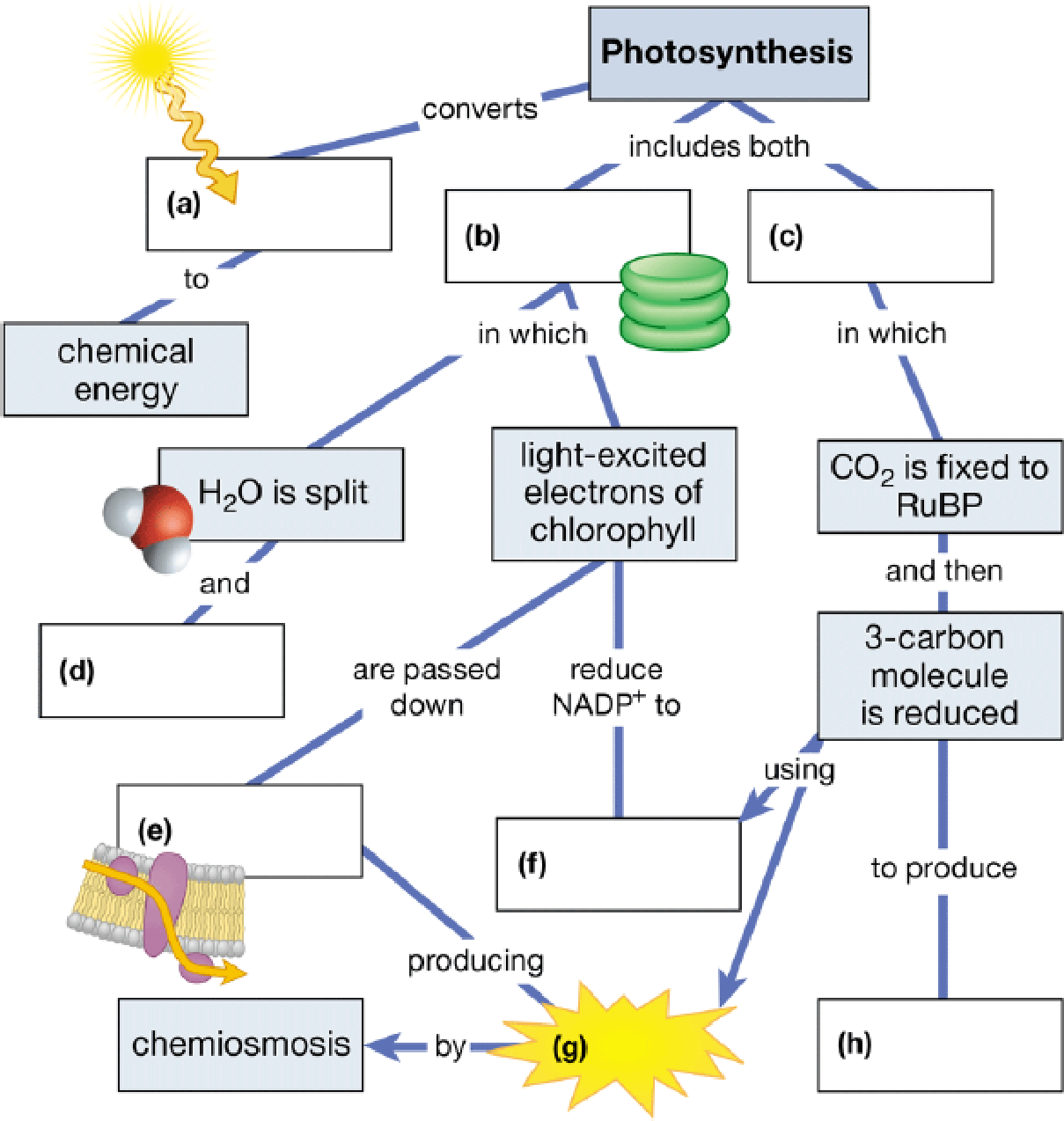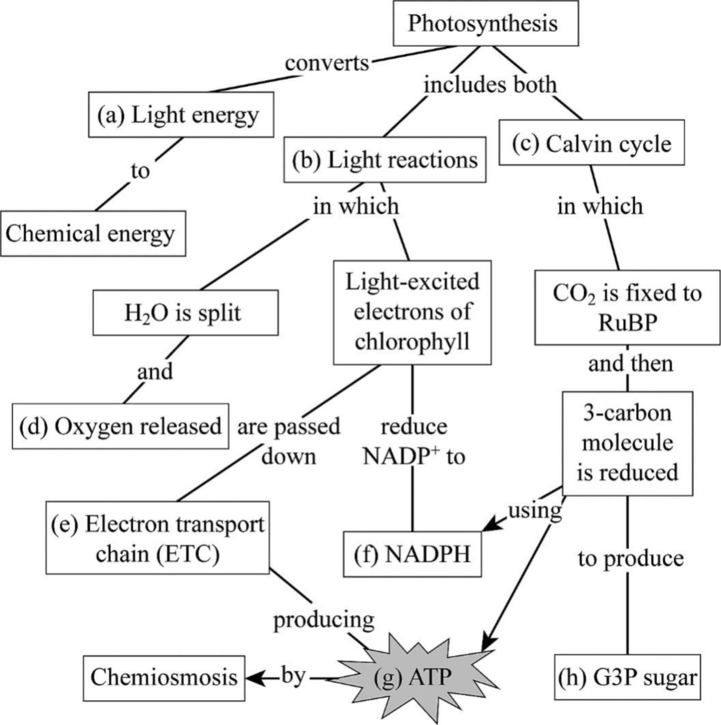
Concept explainers
Complete this summary map of photosynthesis.

To complete: The connect map to summarize the major steps in photosynthesis.
Concept introduction: Photosynthesis is a vital process in primary producers, plants. Plants use light energy and carbon dioxide (CO2) from the atmosphere and produce sugars that are stored in various parts of the plants. The most edible ones are consumed by the primary consumers. Several compounds are converted and recycled in the process of photosynthesis. Several reactions of photosynthesis take place in the chloroplast of the plant cell, which contains the green pigment chlorophyll.
Answer to Problem 1CC
The Fig.1 shows all the key processes in photosynthesis.
Pictorial representation:
The Fig. 1shows the summary of all the processes involved in photosynthesis.

Fig 1: Summary of various steps in photosynthesis.
Explanation of Solution
(a)
Correct answer: Light energy
In the process of photosynthesis, photons from light energy are converted into chemical energy. In the visible spectrum of light, the red and blue wavelengths are used to initiate the reactions of photosynthesis. The light energy is used up to break the water molecule by the process called photolysis of water, which is the first step in photosynthesis.
Hence, the correct answer is light energy.
(b)
Correct answer: Light reactions
Photosynthesis includes two reactions, namely, light-dependent and light-independent reactions. Light reactions are those that are dependent on the incident light energy on the chloroplast. Light reactions include two sub steps. One reaction is the photolysis of water where light energy is used up to break the water molecules to produce an oxygen molecule and protons. The second reaction is where these protons and the energy released during photolysis of water are used up to excite the electrons in the chlorophyll.
Hence, the correct answer is light reactions.
(c)
Correct answer: Calvin cycle
The CBB (Calvin–Benson–Bassham) cycle or Calvin’s cycle is a series of reactions that take place in the stroma of the chloroplast. The Calvin’s cycle is a light-independent reaction, which is also known as the dark reaction. In the Calvin’s cycle, the atmospheric carbondioxide is fixed with ribulose1, 5-bisphosphate to produce two 3-carbon compounds. One of the two 3-carbon compounds is reduced to form another sugar.
Hence, the correct answer is the Calvin cycle
(d)
Correct answer: Oxygen released
During one of the light reactions, that is, photolysis of water, the light energy is used up to break two molecules of water to produce one molecule of oxygen, 4 electrons, and 4 protons (H+). The oxygen molecule then escapes the chloroplast and is released into the atmosphere.
Hence, the correct answer is oxygen released
(e)
Correct answer: Electrontransportchain(ETC)
During the second light reaction of photosynthesis, the electrons released from photolysis of water are passed on through the photosystem II and photosystem I and are then sent to the electron transport chain. In the electron transport chain, the protons released during photolysis of water are used by F0-F1 ATP synthase to produce ATP.
Hence, the correct answer is the electron transport chain (ETC)
(f)
Correct answer: Nicotinamide adenine dinucleotide phosphate (NADPH)
During the second light reaction of photosynthesis, the electrons released from photolysis of water are passed on through the photosystem II and photosystem I, which at the end of photosystem II reduce NAD+ to NADPH. This NADPH is then used up during the hexose monophosphate pathway to produce several sugars, and it is also used during the Calvin’s cycle to produce sugars.
Hence, the correct answer is NADPH
(g)
Correct answer: ATP
The electrons released from photolysis of water are passed on through the photosystem II and then from the photosystem to the electron transport chain. In the electron transport chain, the protons released during photolysis of water are used by F0-F1 ATP synthase present on the thylakoid membrane of the chloroplast to produce ATP. This ATP is used up along with NADPH to produce several sugars in the Calvin’s cycle.
Hence, the correct answer is ATP
(h)
Correct answer: Glyceraldehyde 3-phosphate (G3P)(sugar)
During the Calvin’s cycle, the NADPH and ATP produced during the light reactions and F0-F1 ATP synthase, respectively, are used up to reduce ribulose 1.5-bisphosphate to produce two molecules of G3P. For every 3 molecules of carbondioxide entering the Calvin’s cycle, one G3P is produced. Few G3Ps are sent for the production of 6-carbon sugars and others are recycled back to produce ribulose 1,5-bisphosphate.
Hence, the correct answer is G3P (sugar)
Want to see more full solutions like this?
Chapter 7 Solutions
Campbell Biology: Concepts and Connections
- Transcription and Translation 1. What is the main function of transcription and translation? (2 marks) 2. How is transcription different in eukaryotic and prokaryotic cells? (2 marks) 3. Explain the difference between pre-mRNA and post-transcript mRNA. (2 marks) 4. What is the function of the following: (4 marks) i. the cap ii. spliceosome iii. Poly A tail iv. termination sequence 5. What are advantages to the wobble feature of the genetic code? (2 marks) 6. Explain the difference between the: (3 marks) i. A site & P site ii. codon & anticodon iii. gene expression and gene regulation 7. Explain how the stop codon allows for termination. (1 mark) 8. In your own words, summarize the process of translation. (2 marks)arrow_forwardIn this activity you will research performance enhancers that affect the endocrine system or nervous system. You will submit a 1 page paper on one performance enhancer of your choice. Be sure to include: the specific reason for use the alleged results on improving performance how it works how it affect homeostasis and improves performance any side-effects of this substancearrow_forwardNeurons and Reflexes 1. Describe the function of the: a) dendrite b) axon c) cell body d) myelin sheath e) nodes of Ranvier f) Schwann cells g) motor neuron, interneuron and sensory neuron 2. List some simple reflexes. Explain why babies are born with simple reflexes. What are they and why are they necessary. 3. Explain why you only feel pain after a few seconds when you touch something very hot but you have already pulled your hand away. 4. What part of the brain receives sensory information? What part of the brain directs you to move your hand away? 5. In your own words describe how the axon fires.arrow_forward
- Mutations Here is your template DNA strand: CTT TTA TAG TAG ATA CCA CAA AGG 1. Write out the complementary mRNA that matches the DNA above. 2. Write the anticodons and the amino acid sequence. 3. Change the nucleotide in position #15 to C. 4. What type of mutation is this? 5. Repeat steps 1 & 2. 6. How has this change affected the amino acid sequence? 7. Now remove nucleotides 13 through 15. 8. Repeat steps 1 & 2. 9. What type of mutation is this? 0. Do all mutations result in a change in the amino acid sequence? 1. Are all mutations considered bad? 2. The above sequence codes for a genetic disorder called cystic fibrosis (CF). 3. When A is changed to G in position #15, the person does not have CF. When T is changed to C in position #14, the person has the disorder. How could this have originated?arrow_forwardhoose a scientist(s) and research their contribution to our derstanding of DNA structure or replication. Write a one page port and include: their research where they studied and the time period in which they worked their experiments and results the contribution to our understanding of DNA cientists Watson & Crickarrow_forwardhoose a scientist(s) and research their contribution to our derstanding of DNA structure or replication. Write a one page port and include: their research where they studied and the time period in which they worked their experiments and results the contribution to our understanding of DNA cientists Watson & Crickarrow_forward
- 7. Aerobic respiration of a protein that breaks down into 12 molecules of malic acid. Assume there is no other carbon source and no acetyl-CoA. NADH FADH2 OP ATP SLP ATP Total ATP Show your work using dimensional analysis here: 3arrow_forwardFor each of the following problems calculate the following: (Week 6-3 Video with 6-1 and 6-2) Consult the total catabolic pathways on the last page as a reference for the following questions. A. How much NADH and FADH2 is produced and fed into the electron transport chain (If any)? B. How much ATP is made from oxidative phosphorylation (OP), if any? Feed the NADH and FADH2 into the electron transport chain: 3ATP/NADH, 2ATP/FADH2 C. How much ATP is made by substrate level phosphorylation (SLP)? D. How much total ATP is made? Add the SLP and OP together. 1. Aerobic respiration using 0.5 mole of glucose? NADH FADH2 OP ATP SLP ATP Total ATP Show your work using dimensional analysis here:arrow_forwardAerobic respiration of one lipid molecule. The lipid is composed of one glycerol molecule connected to two fatty acid tails. One fatty acid is 12 carbons long and the other fatty acid is 18 carbons long in the figure below. Use the information below to determine how much ATP will be produced from the glycerol part of the lipid. Then, in part B, determine how much ATP is produced from the 2 fatty acids of the lipid. Finally put the NADH and ATP yields together from the glycerol and fatty acids (part A and B) to determine your total number of ATP produced per lipid. Assume no other carbon source is available. 18 carbons fatty acids 12 carbons glycerol . Glycerol is broken down to glyceraldehyde 3-phosphate, a glycolysis intermediate via the following pathway shown in the figure below. Notice this process costs one ATP but generates one FADH2. Continue generating ATP with glyceraldehyde-3-phosphate using the standard pathway and aerobic respiration. glycerol glycerol-3- phosphate…arrow_forward
- Don't copy the other answerarrow_forward4. Aerobic respiration of 5 mM acetate solution. Assume no other carbon source and that acetate is equivalent to acetyl-CoA. NADH FADH2 OP ATP SLP ATP Total ATP Show your work using dimensional analysis here: 5. Aerobic respiration of 2 mM alpha-ketoglutaric acid solution. Assume no other carbon source. NADH FADH2 OP ATP Show your work using dimensional analysis here: SLP ATP Total ATParrow_forwardBiology You’re going to analyze 5 ul of your PCR product(out of 50 ul) on the gel. How much of 6X DNAloading buffer (dye) are you going to mix with yourPCR product to make final 1X concentration ofloading buffer in the PCR product-loading buffermixture?arrow_forward
 Concepts of BiologyBiologyISBN:9781938168116Author:Samantha Fowler, Rebecca Roush, James WisePublisher:OpenStax College
Concepts of BiologyBiologyISBN:9781938168116Author:Samantha Fowler, Rebecca Roush, James WisePublisher:OpenStax College
 Biology 2eBiologyISBN:9781947172517Author:Matthew Douglas, Jung Choi, Mary Ann ClarkPublisher:OpenStax
Biology 2eBiologyISBN:9781947172517Author:Matthew Douglas, Jung Choi, Mary Ann ClarkPublisher:OpenStax Biology Today and Tomorrow without Physiology (Mi...BiologyISBN:9781305117396Author:Cecie Starr, Christine Evers, Lisa StarrPublisher:Cengage Learning
Biology Today and Tomorrow without Physiology (Mi...BiologyISBN:9781305117396Author:Cecie Starr, Christine Evers, Lisa StarrPublisher:Cengage Learning Biology: The Dynamic Science (MindTap Course List)BiologyISBN:9781305389892Author:Peter J. Russell, Paul E. Hertz, Beverly McMillanPublisher:Cengage Learning
Biology: The Dynamic Science (MindTap Course List)BiologyISBN:9781305389892Author:Peter J. Russell, Paul E. Hertz, Beverly McMillanPublisher:Cengage Learning Biology (MindTap Course List)BiologyISBN:9781337392938Author:Eldra Solomon, Charles Martin, Diana W. Martin, Linda R. BergPublisher:Cengage Learning
Biology (MindTap Course List)BiologyISBN:9781337392938Author:Eldra Solomon, Charles Martin, Diana W. Martin, Linda R. BergPublisher:Cengage Learning





